Dogsled Racing

I am a sucker for the unusual and new, and often get roped
into helping out with completely random activities. This one
resulted from an off-hand comment about my interest in dog-sledding
to Christine, the MIT Outing Club VP. One cold January Friday,
Christine called me about helping her out with transportation
to a dogsled race, where she and a few other club members were
supposed to help out. The only catch was that the race took place
in Meredith, NH, and we had to be there at 9 am the next day.
This meant that I would be skipping my usual Saturday long sleep-in.
Since I had never before seen a dogsled race first hand, I
decided that this chance was too good to pass up. So at 7 am
or so on Saturday, our group left MIT and headed north. After
a mandatory stop at the Einstein Brothers' Bagels in Concord
(Exit 14) arrived at the race site - a frozen lake near Meredith.


 The
set-up area itself occupied what looked like an empty lumber
yard, with passage ways formed in between columns of pickup trucks.
The trucks themselves were equipped with dog pens, The
set-up area itself occupied what looked like an empty lumber
yard, with passage ways formed in between columns of pickup trucks.
The trucks themselves were equipped with dog pens, 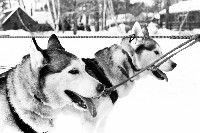 which
seemed awfully small at first, but the dogs did not seem to mind
as they would be getting plenty of fresh air and exercise that
day. As our group meandered between the cars we wondered why
the dogs looked so unlike the big and furry huskies that all
of us associated with dog sleds. A pair of friendly racers finally
told us that the breed most often used in the sprint races was
actually a different breed altogether, generally referred to
as Alaskan huskies. These dogs are bred for speed rather than
endurance, and due to their short coats are better adapted to
the milder climate of New England than true Siberian huskies.
The crossing of breeds produces peculiar colorations in some
dogs. Perhaps the best example of this was a blue and brown eyed
husky that stared at us from his pen. which
seemed awfully small at first, but the dogs did not seem to mind
as they would be getting plenty of fresh air and exercise that
day. As our group meandered between the cars we wondered why
the dogs looked so unlike the big and furry huskies that all
of us associated with dog sleds. A pair of friendly racers finally
told us that the breed most often used in the sprint races was
actually a different breed altogether, generally referred to
as Alaskan huskies. These dogs are bred for speed rather than
endurance, and due to their short coats are better adapted to
the milder climate of New England than true Siberian huskies.
The crossing of breeds produces peculiar colorations in some
dogs. Perhaps the best example of this was a blue and brown eyed
husky that stared at us from his pen.


The sleds themselves are also quite interesting, and more
complex than they seem at first glance. The traditional wood
construction still dominates, made competitive by the addition
of Teflon or other plastic runners. The sleds are quite flexible
in torsion, allowing the racer to lean into turns and carve in
a manner much similar to a skier. A brake - snook - is used to
prevent the sled from overtaking the dogs on downhill slopes.
The whole contraption is flexibly bound by leather or synthetic
straps.
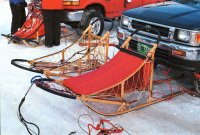
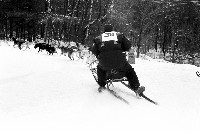
Around 9:30, the races started, and our little group split
up and headed to various places on the course to help out with
guiding the dogs. Mushing definitely takes a while to learn,
and the dogs themselves require long training. To make the driver's
life easier, race helpers stake out the turns and help keep the
dog teams on the proper path.. Nonetheless, a few times during
the races a pack's lead dog would become confused and veer off
course, much to the musher's dismay. Later some of the drivers
told us stories about sixteen dog team taking off after a rabbit,
tangling and destroying everything in the process. I guess then
for the long races like the Iditarod, the driver must have even
better control of his pack, not an easy task. In NH complications
also stem from the fact that the dogs share trails with snowmobiles.
Needles to say, a suddenly approaching snowmobile may startle
and confuse the dog pack much more thoroughly than a rabbit.
 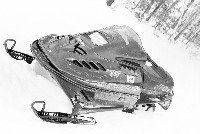 As
a side note, the Mech.E. in me finds snow mobiles quite amazing
works of engineering. Given that they can go over 120 mph on
flat trails, I am not surprised that they can also hydroplane
over water. Pretty amazing power stuffed into a rather small
machine. On the other hand, the backpacker and climber in me
would like to quiet them down just a little bit. Why do they
need to be that noisy? What's wrong with good mufflers? Then
again, I never understood the American fascination with Harley
Davidson either, so maybe there is some fundamental noise related
love that I, as a European, missed out on. But my guess is that
sooner or later someone will get pissed enough that the noise
issue will become important. Anyway, enough proselytizing. As
a side note, the Mech.E. in me finds snow mobiles quite amazing
works of engineering. Given that they can go over 120 mph on
flat trails, I am not surprised that they can also hydroplane
over water. Pretty amazing power stuffed into a rather small
machine. On the other hand, the backpacker and climber in me
would like to quiet them down just a little bit. Why do they
need to be that noisy? What's wrong with good mufflers? Then
again, I never understood the American fascination with Harley
Davidson either, so maybe there is some fundamental noise related
love that I, as a European, missed out on. But my guess is that
sooner or later someone will get pissed enough that the noise
issue will become important. Anyway, enough proselytizing.
Back at the the starting area, Christine and a few other MITOCers
involved themselves with bringing the dogs to the starting line,
as well as helping with just keeping the teams in order. With
up to sixteen hyperactive dogs trying to bolt in as many directions,
I did not envy them. Somehow they seemed to enjoy it anyway.
Seeing the dog team suddenly unite in a sprint away from the
starting line, spurred by a hearty "GO!" from
the sound car, I think I finally understood why people like this
sport.
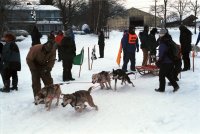
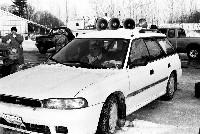


 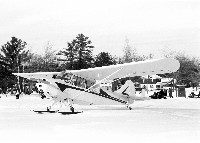 Late
in the day, a plane landed on the snow of the lake. That was
probably the first time I had seen a plane with skis instead
of wheels, but somehow I was the only one around who showed any
interest. Maybe everyone else was just too busy with the race. Late
in the day, a plane landed on the snow of the lake. That was
probably the first time I had seen a plane with skis instead
of wheels, but somehow I was the only one around who showed any
interest. Maybe everyone else was just too busy with the race.
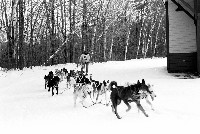  Just
a technical side note: taking photos over a snowy background
requires special care in the use of the metering. I found that
I achieve the best results by spot-metering off the subject,
recomposing, and then slightly underexposing by maybe 1/2 f-stop.
Still, quite a few of my photos have the snow perfectly exposed,
and the subject of the picture perfectly black... Matrix metering
on my N70, predictably enough, consistently causes severe underexposure
in almost all pictures. I guess there may be an easier way, but
I still need to find it... Just
a technical side note: taking photos over a snowy background
requires special care in the use of the metering. I found that
I achieve the best results by spot-metering off the subject,
recomposing, and then slightly underexposing by maybe 1/2 f-stop.
Still, quite a few of my photos have the snow perfectly exposed,
and the subject of the picture perfectly black... Matrix metering
on my N70, predictably enough, consistently causes severe underexposure
in almost all pictures. I guess there may be an easier way, but
I still need to find it...

 |